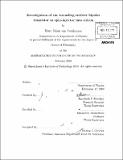| dc.contributor.advisor | Jagadeesh S. Moodera and Mildred S. Dresselhaus. | en_US |
| dc.contributor.author | Van Veenhuizen, Marc Julien | en_US |
| dc.contributor.other | Massachusetts Institute of Technology. Dept. of Physics. | en_US |
| dc.date.accessioned | 2011-05-23T18:01:46Z | |
| dc.date.available | 2011-05-23T18:01:46Z | |
| dc.date.copyright | 2010 | en_US |
| dc.date.issued | 2010 | en_US |
| dc.identifier.uri | http://hdl.handle.net/1721.1/63011 | |
| dc.description | Thesis (Ph. D.)--Massachusetts Institute of Technology, Dept. of Physics, 2010. | en_US |
| dc.description | Cataloged from PDF version of thesis. | en_US |
| dc.description | Includes bibliographical references (p. 185-196). | en_US |
| dc.description.abstract | In this thesis is discussed the tunneling emitter bipolar transistor as a possible spin-injector into silicon. The transistor has a metallic emitter which as a spin-injector will be a ferromagnet. Spin-polarized electrons from the ferromagnet tunnel directly into the conduction band of the base of the transistor and are subsequently swept into the collector. The tunneling emitter bipolar transistor as a spin-injector allows for large spin-polarized currents and naturally overcomes the conductivity mismatch and Schottky barrier formation. In this work, the various aspects of the transistor are analyzed. The transfer of spin-polarization across the base-collector junction is simulated. The oxide MgO is considered as a tunnel barrier for the transistor. Electron spin resonance is proposed as a measurement technique to probe the spin-polarization injected into the collector. The fabrication of the transistors is discussed and the importance of the tunnel barrier for the device operation is fully analyzed. The observation of negative differential transconductance in the transistor is explained. A number of side- or unrelated studies are presented as well. A study on scattered and secondary electrons in e-beam evaporation is described. Spin-orbit coupling induced spin-interference of ring-structures is proposed as a spin-detector. A new measurement technique to probe bias dependent magnetic noise in magnetic tunnel junctions is proposed. Also, an IV fitting program that can extract the relative importance of the tunnel and Schottky barrier is discussed and employed to fit the base-emitter IV characteristics of the transistor. The development of several fabrication and experimental tools is described as well. | en_US |
| dc.description.statementofresponsibility | by Marc Julien van Veenhuizen. | en_US |
| dc.format.extent | 196 p. | en_US |
| dc.language.iso | eng | en_US |
| dc.publisher | Massachusetts Institute of Technology | en_US |
| dc.rights | M.I.T. theses are protected by
copyright. They may be viewed from this source for any purpose, but
reproduction or distribution in any format is prohibited without written
permission. See provided URL for inquiries about permission. | en_US |
| dc.rights.uri | http://dspace.mit.edu/handle/1721.1/7582 | en_US |
| dc.subject | Physics. | en_US |
| dc.title | Investigation of the tunneling emitter bipolar transistor as spin-injector into silicon | en_US |
| dc.type | Thesis | en_US |
| dc.description.degree | Ph.D. | en_US |
| dc.contributor.department | Massachusetts Institute of Technology. Department of Physics | |
| dc.identifier.oclc | 720919549 | en_US |
